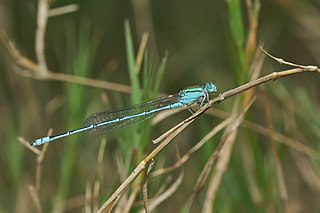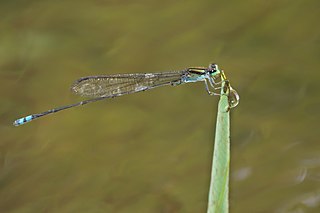
The blue riverdamsel, Pseudagrion microcephalum is a common species of damselfly in the family Coenagrionidae. It is also known as the blue sprite and blue grass dart.

Esme longistyla is damselfly in the family Platycnemididae. It is commonly known as the Nilgiri bambootail. It is endemic to Western Ghats in India.

Lestes praemorsus is a damselfly species in the family Lestidae. It is commonly known as the scalloped spreadwing or sapphire-eyed spreadwing. It is very widely distributed from India to China and south to New Guinea.

Copera vittata is a species of damselfly in the family Platycnemididae. It is native to Asia, where it is widely distributed from India to Indonesia. It is known commonly as the blue bush dart. There are several subspecies and it may represent a species complex.

Lestes elatus is a species of damselfly in the family Lestidae, the spreadwings. It is known commonly as the emerald spreadwing. It is native to India, Thailand and Sri Lanka.

Copera marginipes, yellow bush dart, is a species of damselfly in the family Platycnemididae. It is native to Asia, where it is widespread and common.

Pseudagrion malabaricum, Malabar sprite, jungle grass dart, is a species of damselfly in the family Coenagrionidae. It is found in India, Sri Lanka, and Myanmar.

Pseudagrion rubriceps, saffron-faced blue dart, is a species of damselfly in the family Coenagrionidae. It is found in many tropical Asian countries.

Anax indicus is a species of dragonfly in the family Aeshnidae. It is found in India, Nepal, Pakistan, Sri Lanka, and Thailand.

Pseudagrion decorum, elegant sprite or three striped blue dart, is a species of damselfly in the family Coenagrionidae. It is found in many tropical Asian countries.

Onychogomphus nilgiriensis is a species of dragonfly in the family Gomphidae. It is endemic to the hill streams of Western Ghats of India.

Ceriagrion olivaceum is a species of damselfly in the family Coenagrionidae. it is commonly known as rusty marsh dart. This species can be found in south and southeast Asia.

Pseudagrion indicum, yellow-striped blue dart or yellow-striped dart, is a species of damselfly in the family Coenagrionidae. It is found only in Western Ghats of India.

Euphaea cardinalis, Travancore torrent dart, is a species of damselfly in the family Euphaeidae.

Euphaea dispar, Nilgiri torrent dart, is a species of damselfly in the family Euphaeidae.

Euphaea fraseri, Malabar torrent dart, is a species of damselfly in the family Euphaeidae. This species is endemic to the Western Ghats; known to occur in various locations up to Goa.
Esme cyaneovittata is damselfly in the family Platycnemididae. It is endemic to Western Ghats in India, south of Palakkad Gap.

Indosticta deccanensis, saffron reedtail is a damselfly species in the family Platystictidae. It is endemic to Western Ghats in India.

Platylestes platystylus is a damselfly species in the family Lestidae. Although this species appears to be widespread, there are very few recent records. This species is known from old records from West Bengal in India, Myanmar, Thailand and Laos. There are recent records from Thailand, Vietnam, Laos and Kerala, South India.

Ischnura rubilio, western golden dartlet, is a species of damselfly in the family Coenagrionidae. It is found in Indian subcontinent and Iran.























